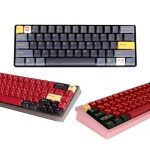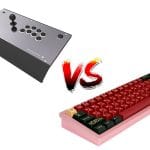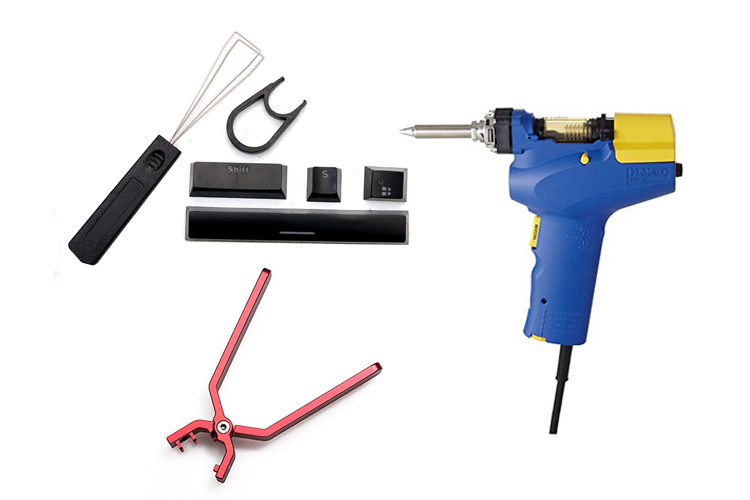
Custom keyboards have become incredibly popular in the past couple of years. This is largely due to how customizable they are. Some people like to redesign their keyboard’s aesthetics, while others are more focused on customizing functionality and performance. Either way, users must be aware of the tools they will need throughout their mechanical keyboard journey to achieve those goals.
When building or maintaining mechanical keyboards, users must be aware of the various tools that are needed. Some tools that will be needed include a soldering iron, mechanical switch lube, and mechanical key switch opener. Users must have a good grasp of these tools to properly customize their mechanical keyboards.
In this article, we will be discussing the various tools that are needed for customizing as well as for maintaining mechanical keyboards. We’ll also discuss which tools are essential and which ones are optional so users can prioritize which ones they will need more often.
Essential Keyboard Tools
Keyboard Keycap Puller
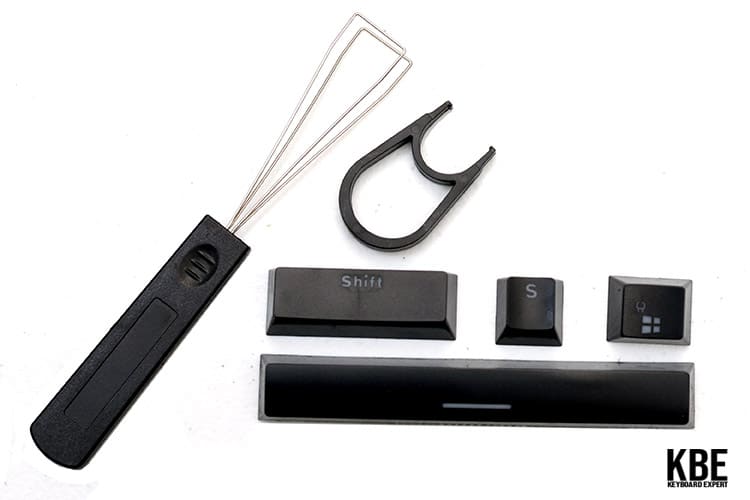
One of the most important tools that any keyboard enthusiast should have is a keycap puller. These simple tools allow the user to remove the keycaps of their keyboards without damaging them. This is incredibly important as removing keycaps allows the user to replace and customize the keycaps and allows the user to clean properly clean their keyboards.
For keycap pullers, there are two main types that can be found in the market: plastic keycap pullers and wire keycap pullers.
Plastic keycap pullers come in many shapes. But the common feature of most of these is that it has two prongs that protrude from the handle.
These two prongs then have two teeth at the end. The gap between the two teeth is tighter than the size of the keycap for it to have a clamping force as it slides along the sides to the bottom of the keycap.
This is the problem with this kind of keycap puller, where it sometimes leaves some scratches on the sides of the keycaps and the edges of the top shell of the keyboard. So this is not recommended, especially for keyboards with paints on the sides, which can easily be damaged. And because this is plastic, it may eventually snap, so it is better to buy a more expensive but less trouble keycap puller.
The second type of keycap puller is the wire puller. Instead of plastic, this one is made with two wires which extend from the handle and act as two hooks to go around and under the keycap. And because it is thin, it poses no threat to the sides of the keycap as it doesn’t need to scrape along the sides. For those who wish to learn more about removing mechanical keyboard keycaps, you can check out our dedicated Keycap Removal Guide.
Mechanical Keyboard Switch Puller
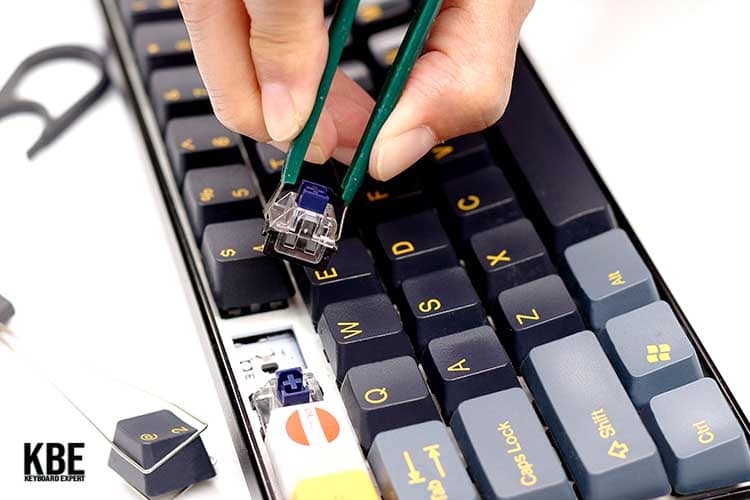
Switch pullers are essential for users who own hot-swap mechanical keyboards. These are the tools that allow users to pull out the mechanical switches.
Just like with keycap pullers, there are also different kinds of switch pullers. Some work better than others, which is why choosing the right one is very important.
There are three main types of switch pullers: the metallic puller, IC puller, and 2-in-1 puller. The metallic puller is a short, thin piece of bent metal; it isn’t very rigid, so you can bend it easily if it gets out of shape. Furthermore, because of its short and thin characteristics, it’s kind of a bit hard to use and sometimes slips out of position when being pressed and accidentally scratches up the plates.
The IC puller is almost the same as the metallic puller. However, IC pullers are longer which usually have a plastic grip, which is easier to use. Unlike the metallic puller, this one is not easily bent, so it is less likely to damage the plates. Lastly, the 2-in-1 puller, which has both a switch and keycap puller on each end, is mainly used by mechanical keyboard enthusiasts.
Mechanical Switch Lube (Krytox 205g0, Trybosis, etc.)
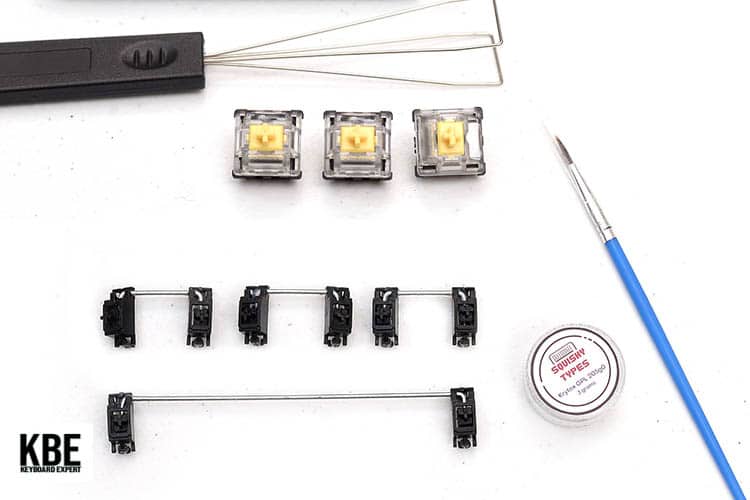
One of the best ways to modify a mechanical keyboard is to add lube to the mechanical switches. Lube often gives switches a smoother feel as well as less noise. Lube is also commonly used to fix rattly stabilizers in the longer keys. With how useful mechanical keyboard lube is, they are a must-have on any keyboard enthusiast’s toolkit.
Different kinds of lube will affect different kinds of switches. That is why it is important to know which type of lube works best for your switches. Tactile switches have a small bump experience with it letting the user feel the response of the operation from the switch. Lubing a tactile switch will eliminate the scratchiness at the tactile bump. Krytox 105 is recommended to use because it is thinner, but Krytox 205G0 will also work if you want to dampen the tactility more.
For linear switches, a lube with higher viscosity is best to use. This type of switch gains the most benefit if lubed. Krytox 205G0 is recommended to use because it is thicker than other lubricants. As for the springs, Krytox 105 Oil is better to use to help prevent the spring ping.
There are also some suggested lubricants with almost the same effects as Krytox. These are Tribosys 3203 and Tribosys 3204. Tribosys 3204 is thinner, which is better for tactile switches, while Tribosys 3203, which is thicker, is better for linear switches.
Apart from the two, clicky switches are generally not recommended to be lubed. Applying lubricants to clicky switches will only result in inconsistent sounds between each switch. Furthermore, it will change the way it feels and may also be reduced to a quieter tactile switch. Still, Krytox 105 Oil can be used on the springs.
Mechanical Keyboard Switch Opener

Anyone who plans on lubing mechanical switches must also own a mechanical switch opener. These tools are required since mechanical switches typically cannot be opened with just your bare hands.
Like anything on this list, there are multiple types of switch openers. Some are relatively affordable and use basic materials such as the 3D Printed Switch Opener. However, there are better tools out there that can get the job done easier and faster. Most enthusiasts recommend the Gateron Switch Opener due to its ease of use and its top-notch build quality.
Optional Tools
Soldering Iron

A soldering iron is not a tool that all users will need. Keyboard enthusiasts who own entry-level keyboards or hot-swap keyboards do not necessarily need to buy these. However, a soldering iron is something that enthusiasts will eventually have to buy, especially when dealing with higher-end keyboards that do not support a Hot-Swap PCB.
A soldering iron is mainly used for melting solder to glue two workpieces that need to be joined. The most common use case for these tools is for soldering switches on a keyboard. It can also be used for soldering Mill-Max sockets to convert a solder-only PCB into a Hot-Swap PCB.
Some soldering irons offer useful features such as temperature regulation settings. The preferred temperature should be at least greater than 350 degrees Celsius and less than 390 degrees Celsius. Staying within the ideal temperature prevents any form of damage to the PCB.
Other soldering iron stations also allow users to change the tip. Some also have integrated ESD protection that ensures the safety of the PCB you are working on.
Solder
Aside from having a good soldering iron, acquiring a fine solder also does an important part in obtaining the best result for your custom keyboard. The reason for this is that cheaper solders usually contain poor fluxes.
In addition, it is highly recommended to pick the right size to use. 63/37 or 60/40 rosin core lead solder is often used as they are easy to desolder. Generally, sizes ranging between .03 and .06 can do the job.
Solder Sucker/Desoldering Tool

Lastly, it is also highly recommended to get proper desoldering tools. These are extremely useful for both beginners and advanced users since mistakes are inevitable. In addition, these tools can also be used to desolder switches from solder-only keyboards.
Again, this isn’t a tool that is required, and beginners shouldn’t immediately go out and buy these. However, It is something to consider in the long run, especially if you plan to test different kinds of switches or build multiple mechanical keyboards.

The KBE team is dedicated to sharing our knowledge and creating useful resources about computer keyboards. This article was written as a team collaboration, combining our knowledge and years of experience using, building and modding keyboards. Meet the team here.

